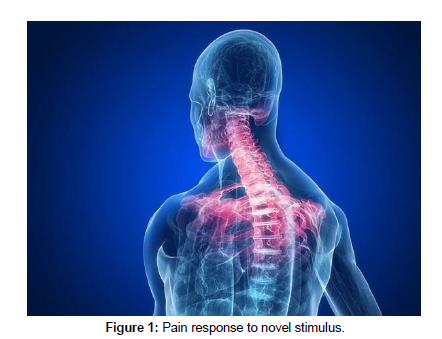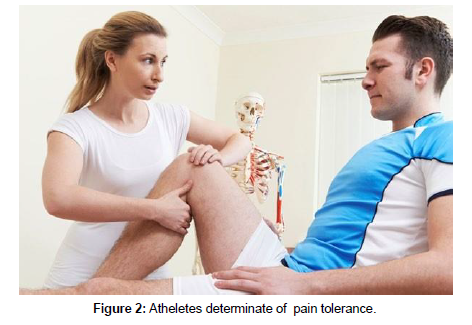Pain Threshold According to Sport Participation
Received: 19-Apr-2023 / Manuscript No. JPAR-23-100196 / Editor assigned: 22-Apr-2023 / PreQC No. JPAR-23-100196 / Reviewed: 06-May-2023 / QC No. JPAR-23-100196 / Revised: 11-May-2023 / Manuscript No. JPAR-23-100196 / Published Date: 18-May-2023 DOI: 10.4172/2167-0846.1000508 QI No. / JPAR-23-100196
Abstract
Differences in athletes’ pain tolerances are a continuing source of interest to many in the sports medicine fields. Numerous investigations have independently examined experimental pain in athletes, based on sex and sport played. However, few have examined the different surfaces of play that may influence an athlete’s pain due to the hardness or the softness of the surface. Some athletes are able to withstand severe pain with much poise, while others react to slight pain with much stress and emotion. Individual differences in coping strategies, sociocultural perspectives, and experiences with pain complicate treating injuries based on pain ratings, as clinicians are relying on reported feelings of pain when considering diagnosis and treatment options. The sensation of pain can be divided into two phases; pain threshold and pain tolerance
Keywords: Diagnosis and treatment; Pain responses; Stimulus; Athletic activities; Physiological differences; Sports medicine
Keywords
Diagnosis and treatment; Pain responses; Stimulus; Ath- letic activities; Physiological differences; Sports medicine
Introduction
Pain threshold is defined as the level of stimulus at which the participant first recognizes pain or discomfort, while pain tolerance is a greater level of stimulus at which the participant requests for the stimulus to stop or be discontinued. There are several factors that may influence pain responses. First, under certain conditions, adaptation to pain occurs; that is a familiar stimulus which will often produce a different pain response compared to a novel stimulus [1]. Repeated stimulus will not elicit the same response that is felt during the first response. Second, many factors influence the amount of pain an individual will tolerate, such as fear, anxiety, and desire for acceptance as shown in (Figure 1). The ability to withstand pain may be related to participation in certain types of athletic events. In many contact sports, the ability to withstand pain appears to be essential to successful performance, while in non-contact sports, the ability to withstand pain may be less critical [2]. The relationship between pain threshold and the selection of athletic activities may reflect basic physiological differences, while the relationship between pain tolerance and the selection of athletic activities may reflect environmental differences.
Methodology
Researchers are beginning to identify specific biological under pinning’s of sex differences in pain, which are also providing some clues to why women and men are treated differently when it comes to pain [3]. It has been found that there are important differences in the way cognitive-affective factors influence the pain responses between the two sexes. Additionally, multiple reviews of the literature have focused on a variety of bio-psychosocial determinants of pain generating the understanding that the sense of pain is a function of multiple factors contributing to a complex phenomenon that still requires exploration to better treat and manage for each individual case [4]. Continued research in this field may lead to a day when sports medicine doctors treat pain in both female and male patients more effectively. Related to sport and athletic competition, a possible determinate of pain is the surface of play and the sport of a particular athlete relative to affect pain tolerance as well as pain threshold. Athletes that run on solid surfaces may build up a pain tolerance not seen in field athletes as shown in (Figure 2). Research specifically targeting surfaces of play and how indoor versus outdoor conditions influence pain tolerance is lacking [5]. The purpose of this paper is to describe the pain tolerance and pain threshold characteristics of collegiate athletes that practice and compete on indoor versus outdoor surfaces. A better understanding of the role that surface of play contributes to an athlete’s pain tolerance may led to a better understanding of how particular athletes deal with pain and allow sports medicine professionals to more easily assess the severity of a sports injury. It was hypothesized that indoor athletes would have higher pain tolerance and pain threshold compared to outdoor athletes. It is thought that indoor athletes may be partially desensitized to pain because of the increased ground reaction forces and the kinematic characteristics of indoor playing surfaces [6]. Two separate experimental pain tests were performed on each participant in randomized order. Participants provided demographic and health history information to determine risk of participation [7]. Participants were excluded from participation if they reported a history of hypertension, coronary artery disease, or upper extremity pain of unknown etiology. Participants were also excluded if they had any current hand or arm injuries and were currently using cryotherapy [8]. Consistent with the current literature, females had significantly lower pain thresholds compared to males in some but not all of the testing procedures. Specifically, differences were observed during the CWIT test, but not in the TPT test. Additionally, males and females did not differ in pain tolerance for both the CWIT and TPT tests [9].
Discussion
Current theories related to differences between males and females include both psychological and physiological factors as possible explanations for the observed phenomenon [10]. This includes the possible Gender Role Expectations of Pain, which includes hesitancy to report pain and sensitivity by males. It is important to note that all testing procedures were completed by the same technician and behind the comfort of a privacy curtain [11]. This is especially relevant when testing experimental pain because of the possible influences of the presence of others and the reporting of pain. A growing body of literature has shown that ethnic differences may also play a role in pain tolerance [12]. For example, African American typically report higher levels of experimental pain than white subjects [13]. This factor needs to be taken into consideration when comparing the basketball and soccer teams in this investigation. The basketball teams recruited for this investigation consisted of a higher percentage of athletes compared to the soccer teams that consisted of a higher percentage of Hispanic and white athletes. Due to the randomization used in recruitment, the racial demographics of the sample adequately represents that of the university teams [14]. Prior to the start of the CWIT, participants were briefed on the criteria used to classify pain threshold and pain tolerance during the study. The tourniquet pain test was conducted using a modified sub- maximal tourniquet procedure. This procedure involved exercising the hand as blood flow to the arm was occluded, causing ischemic pain.
Conclusion
A better understanding of differences in pain tolerance could lead to further research into determinants of pain and how the surfaces of play could affect an athlete’s tolerance for pain. The information gathered from this investigation could be utilized by athletic trainers, team physicians, and coaches to better understand how athletes perceive pain.
Acknowledgement
None
Conflict of Interest
None
References
- Ozgoli G, Goli M, Moattar F (2009) Comparison of effects of ginger, mefenamic acid, and ibuprofen on pain in women with primary dysmenorrhea. J Altern Complement Med US 15:129-132.
- Raeder J, Dahl V (2009) Clinical application of glucocorticoids, antineuropathics, and other analgesic adjuvants for acute pain management. CUP UK: 398-731.
- Świeboda P, Filip R, Prystupa A, Drozd M (2013) Assessment of pain: types, mechanism and treatment. Ann Agric Environ Med EU 1:2-7.
- Nadler SF, Weingand K, Kruse RJ (2004) The physiologic basis and clinical applications of cryotherapy and thermotherapy for the pain practitioner. Pain Physician US 7:395-399.
- Trout KK (2004) The neuromatrix theory of pain: implications for selected non-pharmacologic methods of pain relief for labor. J Midwifery Wom Heal US 49:482-488.
- Cohen SP, Mao J (2014) Neuropathic pain: mechanisms and their clinical implications. BMJ UK 348:1-6.
- Mello RD, Dickenson AH (2008) Spinal cord mechanisms of pain. BJA US 101:8-16.
- Bliddal H, Rosetzsky A, Schlichting P, Weidner MS, Andersen LA, et al. (2000) A randomized, placebo-controlled, cross-over study of ginger extracts and ibuprofen in osteoarthritis. Osteoarthr Cartil EU 8:9-12.
- Maroon JC, Bost JW, Borden MK, Lorenz KM, Ross NA, et al. (2006) Natural anti-inflammatory agents for pain relief in athletes. Neurosurg Focus US 21:1-13.
- Kahn LH (2006) Confronting zoonoses, linking human and veterinary medicine. Emerg Infect Dis US 12:556-561.
- Bidaisee S, Macpherson CNL (2014) Zoonoses and one health: a review of the literature. J Parasitol 2014:1-8.
- Cooper GS, Parks CG (2004) Occupational and environmental exposures as risk factors for systemic lupus erythematosus. Curr Rheumatol Rep EU 6:367-374.
- Barbhaiya M, Costenbader KH (2016) Environmental exposures and the development of systemic lupus erythematosus. Curr Opin Rheumatol US 28:497-505.
- Birnesser H, Oberbaum M, Klein P, Weiser M (2004) The Homeopathic Preparation Traumeel® S Compared With NSAIDs For Symptomatic Treatment Of Epicondylitis. J Musculoskelet Res EU 8:119-128.
Indexed at, Google Scholar, Crossref
Indexed at, Google Scholar, Crossref
Indexed at, Google Scholar, Crossref
Indexed at, Google Scholar, Crossref
Indexed at, Google Scholar, Crossref
Indexed at, Google Scholar, Crossref
Indexed at, Google Scholar, Crossref
Indexed at, Google Scholar, Crossref
Indexed at, Google Scholar, Crossref
Indexed at, Google Scholar, Crossref
Indexed at, Google Scholar, Crossref
Indexed at, Google Scholar, Crossref
Citation: Thomas H (2023) Pain Threshold According to Sport Participation. J Pain Relief 12: 511. DOI: 10.4172/2167-0846.1000508
Copyright: © 2023 Thomas H. This is an open-access article distributed under the terms of the Creative Commons Attribution License, which permits unrestricted use, distribution, and reproduction in any medium, provided the original author and source are credited.
Select your language of interest to view the total content in your interested language
Share This Article
Recommended Journals
Open Access Journals
Article Tools
Article Usage
- Total views: 1221
- [From(publication date): 0-2023 - Jul 19, 2025]
- Breakdown by view type
- HTML page views: 945
- PDF downloads: 276


